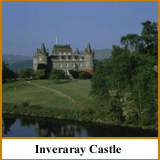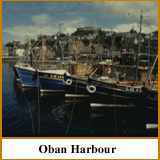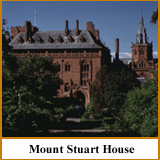

 |
 |
|
|
|
|
South
of Scotland
| West Highlands & Islands, Loch
Lomond, Stirling & Trossachs |
Perthshire, Angus & Dundee and Kingdom of Fife | The
Highlands of Scotland | Grampian
Highlands, Aberdeen & North East Coast | The
Outer Islands - Orkney, Shetland and Western Isles | Edinburgh
- City, Coast and Countryside | Greater
Glasgow & Clyde Valley
|
|||
| WEST
HIGHLANDS & ISLANDS, LOCH LOMOND, STIRLING & TROSSACHS |
||||
| From the romantic Isles of Argyll in the west to the gentle hills east of Stirling, this is the crossroads of Scotland, where the lowlands meet the West Highlands. | ||||
|
ROYAL STIRLING In olden days, all routes led to Stirling. Because of its strategic position, whoever held Stirling Castle controlled the Scottish nation. The Battle of Bannockburn in 1314, one of the most significant conflicts of the Scottish Wars of Independence, was fought within sight of its walls. Led by Robert the Bruce, the Scots defeated the English occupying forces and gained almost three centuries of independence. Today, Stirling Castle still watches over the Old Town of Stirling with its many picturesque buildings. Close by is the National Wallace Monument, a tribute to Scotland's first freedom fighter, Sir William Wallace, whose struggle to free Scotland from England's occupation was portrayed in the unforgettable Oscar-winning movie, "Braveheart". THE TROSSACHS AND LOCH LOMOND Close to Stirling, the Trossachs, with their heather-clad hills and lochs half-hidden in woodlands have attracted generations in search of the picturesque. There are plenty of walks and marked trails through the woods and on to the peaks. Start your Trossachs adventure from the Rob Roy and Trossachs Visitor Centre in Callander. Rob Roy MacGregor was a real life Highlander, cattle dealer and outlaw who became a Scottish folk hero, a story portrayed in the Hollywood film "Rob Roy". To the west, Loch Lomond, famed in song, also offers a choice of cruising or a chance to walk the West Highland Way, the official long distance footpath, which runs through the wooded slopes of its eastern bank. Road and rail run parallel to the walking route. They climb dramatic Glen Falloch to the junction community of Crianlarich, surrounded by the mighty hills of Breadalbane (literally, in Gaelic, meaning the high grounds of Scotland). The charming village of Killin with its folklore centre is nearby. Westward again lies the small village of Tyndrum, a popular stopover place for the West Highland Way walkers. This upland area is of great botanical interest and is enjoyed by walkers and wildlife enthusiasts alike. In the other direction, to the south from Loch Lomond, you will find the former shipbuilding town of Dumbarton with Dumbarton Castle perched on a conspicuous rock guarding the River Clyde approaches. There are cruising options in plenty on the sheltered waters of the Clyde estuary. Though a favourite haunt of yachting enthusiasts, there is also a programme of pleasure cruises revealing the grandeur of the sea-lochs, from resorts such as Dunoon and Helensburgh. THE LOWLAND EDGE East of Stirling, the steep slopes of the Ochil Hills overlook the Hillfoots towns strung together by a common heritage in textile weaving and forming a trail, which starts from Scotland's Mill Trail Visitor Centre in Alva. On the other side of the River Forth, the town of Falkirk features Callender House as just one of its attractions. Set in attractive parkland, this mansion has connections with Mary, Queen of Scots and here, costumed servants bring to life a working kitchen of the 1820's. Nearby, a past of a different kind is evoked by the Bo'ness and Kinneil Railway, with its recreation of a typical Scottish branch line from the days of steam. To the south and west of Stirling, the beautiful hills known as the "Campsie Fells" provide the backdrop for many delightful rural villages. THE WEST HIGHLANDS Mild Atlantic southwesterly winds prevail on the western seaboard and create a climate without extremes, much appreciated by gardeners. The glorious gardens of Argyll and Bute are the result. Visit Achamore Garden or Jura House Garden as examples of mature woodland gardens on the Hebrides. Enjoy the wild setting of Crarae Garden on Loch Fyne, the specialties of Arduaine Garden to the south of Oban or the grand scale of the Younger Botanic Garden by Dunoon, with giant redwoods and thriving rhododendrons.
Westward loops through Knapdale's woodland to a rugged seacoast, giving fine views of the Hebridean islands of Jura and Islay. There are magnificent seascapes to be enjoyed all the way down the Kintyre peninsula. Near its southern end is the town of Campbeltown, which boasts a ferry connection to Northern Ireland. Here too is the famed Macrihanish Golf Links, as well as the Mull of Kintyre right at the tip, offering great views at sunset. Returning north and following the long saltwater reaches of Loch Fyne, the fascinating Auchindrain Highland Township is an authentic survivor from earlier rural times. Inveraray itself is one of the most handsome of Scottish towns. Inveraray Castle is the seat of the Clan Campbell, while other attractions include the popular Inveraray Jail Museum. ISLANDS OF THE WEST Rugged scenic spectacles, castles and the tiny adjacent island of Iona are among the many attractions of Mull. Whether approaching by ferry from Oban, via the main route or from Lochaline in Morven, visitors arrive within easy reach of both Duart Castle, the restored seat of the Clan Maclean and Torosay Castle, a charming and friendly Victorian mansion. Mull Little Railway runs from the Craignure ferry pier to Torosay and back. All who visit the tiny island of Iona are charmed by the sense of peace and stillness pervading at its ancient abbey, which was the cradle of Christianity in Scotland. Outdoor lovers visit Mull for the adventurous walking along its spectacular coastline to places such as the Carsaig Arches or The Burg, with its ancient fossil tree embedded in the rocky cliff. Islay and Jura are two contrasting islands. Islay has a strong sense of a vibrant working community and is a centre for whisky distilling. Empty beaches where seals bask, outstanding bird-life, wild seascapes and the exquisite perfection of the 8th century Kildalton Cross, testimony to the expertise of its early Christian craftsmen, are some of the other attractions. By contrast, Jura is a veritable island wilderness, whose peaks, the Paps of Jura, watch over an empty moorland landscape given over to red deer. Ferry schedules make it possible to combine a visit to the two islands of Islay and Colonsay, using Oban and Tarbert on the mainland, if you time it right. The very essence of a small Hebridean island, Colonsay offers a gentle and peaceful outdoor experience. Coll and Tiree, just beyond Mull, also have many enthusiasts. Both low-lying, Tiree in particular is noted for its good sunshine records and is a favourite of the surfing fraternity. Hebridean islands come in all sizes. Just one popular excursion (from both Mull and the mainland) goes to Staffa, noted for its unusual rock formations and caves, the best known of which is Fingal's Cave. Other islands to explore include Lismore in Loch Linnhe and Kerrera, just offshore from Oban. In fact, there is a Hebridean island to suit every schedule. You can, for example reach Seil Island, located south of Oban, in just a moment by crossing a picturesque hump-backed 18th century bridge, known as "The Bridge over the Atlantic". |
||||
|
 Here
the lowlands meet the mountains of the north and west. Both the Trossachs
and Loch Lomond have enthralled travellers since Sir Walter Scott's writings
first popularised the area in the early 19th century. The romantic landscapes
and islands of Argyll are also dramatic but the gentler hills and communities
of the Lowland edge, by Falkirk, around Clackmannanshire and in Stirling
- focal points of the nation's history - have plenty to attract visitors.
Here
the lowlands meet the mountains of the north and west. Both the Trossachs
and Loch Lomond have enthralled travellers since Sir Walter Scott's writings
first popularised the area in the early 19th century. The romantic landscapes
and islands of Argyll are also dramatic but the gentler hills and communities
of the Lowland edge, by Falkirk, around Clackmannanshire and in Stirling
- focal points of the nation's history - have plenty to attract visitors. The
resort and ferry port of Oban features a range of attractions - the
Highland Theatre, Oban Distillery, Oban Experience, Oban Glass
and A World in Miniature, to name but a few. Touring routes
south from Oban offer a wealth of other places to visit, including little
Kilmartin with its prehistoric sites. At the Loch Fyne end
of the picturesque Crinan Canal, the handsome little town of Lochgilphead
marks the start of the peninsula running down through the highly attractive
area of Knapdale into Kintyre.
The
resort and ferry port of Oban features a range of attractions - the
Highland Theatre, Oban Distillery, Oban Experience, Oban Glass
and A World in Miniature, to name but a few. Touring routes
south from Oban offer a wealth of other places to visit, including little
Kilmartin with its prehistoric sites. At the Loch Fyne end
of the picturesque Crinan Canal, the handsome little town of Lochgilphead
marks the start of the peninsula running down through the highly attractive
area of Knapdale into Kintyre. Travelling
around the head of Loch Fyne and turning southwards brings the visitor
to the Cowal Peninsula, with attractive wooded countryside and views of
the Kyles of Bute at its southern end. The island of Bute is easy to reach
and is a peaceful place with the traditional resort of Rothesay as its
main town. Four miles from Rothesay is the magnificently ornate 19th century
stately home, Mount Stuart, a Gothic fantasy in marble and
stained glass.
Travelling
around the head of Loch Fyne and turning southwards brings the visitor
to the Cowal Peninsula, with attractive wooded countryside and views of
the Kyles of Bute at its southern end. The island of Bute is easy to reach
and is a peaceful place with the traditional resort of Rothesay as its
main town. Four miles from Rothesay is the magnificently ornate 19th century
stately home, Mount Stuart, a Gothic fantasy in marble and
stained glass.